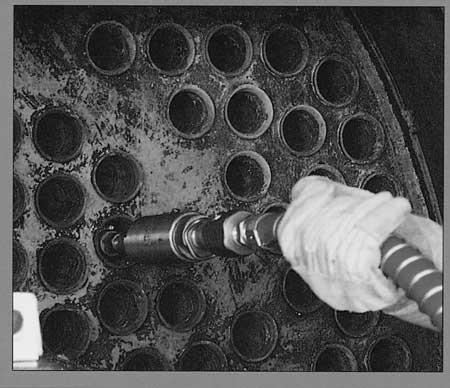| TO FUNCTION efficiently, every tube-type heat exchanger device – whether a hot water or steam boiler, condenser, or an exchanger heating or cooling a liquid or gas – requires that the surface of the tubes be clean and scale-free. The formation of mud deposits, hard or soft scale on the transfer surfaces of the tubes can drastically reduce the flow of heat exchange through the tube walls. These formations may consist of silicates, sulphates, carbonates, calcium, organic growth, etc. The fact is, all scale formations are insulators and therefore their presence on heat exchange surfaces cannot be tolerated. Quite often, fouling agents that cause scale also have chemical characteristics that are highly corrosive to the tube material. In addition to the gradual but increasing loss of heat exchange efficiency, a build-up of scale on a tube’s inner diameter decreases the size of the tube and reduces the flow of either the coolant or the fluid to be cooled through the unit. As the flow through the heat exchanger and the efficiency of the heater or cooler decreases, the entire system must work harder, calling for increased pump horsepower, increased flows of fuel etc, to overcome the deteriorating effectiveness of the unit. This, together with the possible damage to the tube walls by the corrosive nature of some of the deposits, creates a strong argument for maintaining scale-free heat transfer surfaces. Two points with regard to the tube to be cleaned must be taken into consideration. Firstly, data on the tube itself and, secondly, the type of deposit. Tube data must include: the tube’s inside diameter and length or the tube’s outside diameter and gauge (wall thickness); whether it is straight or curved; the minimum radius of curvature; and other pertinent dimensional considerations. Once this criteria has been established, it is then a question of selecting tube cleaning equipment best suited for the job – either an ‘internal type’ or an ‘external type’. An internal type cleaner is one in which both the drive motor and the cleaning tool enter the tube and is generally used for cleaning the straight or curved tubes found in boilers, stills, condensers and other exchange apparatus with comparatively large tubes. External cleaners – those with the driving motor external to the tube and driving the tool with a length of rigid, hollow shafting or flexible shafting – are best suited for cleaning the small straight tubes typical of those found in heat exchangers and some condensers. |
Contact: ascott@elliott-scott.com
|






